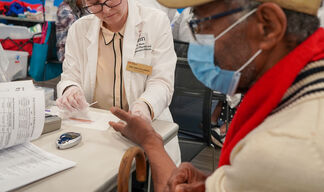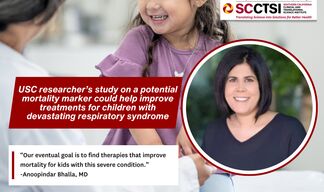SC CTSI-Supported Researcher Discusses Transgender Community with Diane Sawyer
Johanna Olson, MD, answered some common questions parents (and the public) have about care for transgender children.
Note: Johanna Olson, MD, SC CTSI K scholar and assistant professor of pediatrics, is an adolescent medicine physician specializing in the care of transgender youth and gender variant children at the USC-affiliated Children’s Hospital of Los Angeles (CHLA).
Here at Children’s Hospital Los Angeles, our Division of Adolescent and Young Adult Medicine that is headed by Marvin Belzer, MD, has been supporting the health of transgender youth for nearly 20 years. Diane Sawyer’s recent interview of B. Jenner on “20/20,” included Johanna Olson, MD, medical director of the Center for Transyouth Health and Development at CHLA as a subject matter expert. In this post, she answers common questions that parents may have about transgender care for children.
What is Transgender?
“Transgender” is a broad term that describes the experience of individuals who have an internal gender identity that differs from the sex they were assigned at birth. Gender identity is an individuals’ internal sense of maleness, femaleness, both or neither.
What causes a person who is born female to identify as male, or vice versa?
DR. OLSON: We don’t know what causes someone to be transgender, but what we’re learning as we’re putting the pieces together is that there are likely many factors. Genetics, hormones or other elements likely play a role. The information that is being discovered now is indicating that the neural wiring in a transgender person’s brain looks more similar to their gender of identity rather than their gender of assignment at birth. What this means is that gender identity is most likely developing in the womb. Much more needs to be explored in order to understand gender identity information.
The Center for Transyouth Health and Development cares for young people, but is it more common to see people make a physical gender transition later in life?
DR. OLSON: People’s life situations are so individual that the ability to transition is different for everyone. Transition occurs most commonly in adulthood because of lack of access to services, information and language to discuss gender. As time goes on, I think transition in youth will become more common than transition in adulthood. We are starting to see the balance shift right now.
Understanding Gender Identification
What are signs that parents should look for to know if their child might benefit from services like those offered by the Center for Transyouth Health and Development?
DR. OLSON: Children tell us about their gender in a lot of ways. It is important for us to listen to what our kids are saying by paying attention to their behaviors and their words. Examples of behaviors indicating distress include kids who are having trouble navigating public spaces or sex-segregated spaces like locker rooms, or kids who are unhappy about their bodies for a variety of reasons.
Clothing is a big area where children will signal that their gender identity is different from their assigned gender. Assigned boys might want to wear dresses or skirts, grow their hair long and ask for things that allow them to be perceived as a girl. Assigned girls may refuse to wear dresses, and prefer boys’ underwear and swim trunks. Many times, parents will think that these behaviors are a phase, caused by having older siblings of the opposite sex, for example. Children may also explore gender online through the use of avatars or via video games.
Younger children tell us who they are by what they like. It is important for parents to take these conversations seriously. Having the conversation is not going to harm anyone; on the other hand, not having the conversation can be very harmful.
Are there children who engage in cross-sex behavior who are not trans?
DR. OLSON: Yes. Many kids who are not transgender engage in cross-sex behavior. Clinical experience and published research has helped us determine that those who are more persistent with their trans-identity in childhood are more likely to be transgender adolescents and adults. Many times they will assert their gender by saying, “I am a boy” or “I am a girl.” They will also often experience distress about the dissonance between their assigned sex at birth and their experienced gender. As they get older and start to get more cultural messages that their behavior is not normal or acceptable, this may increase the level of stress that they feel.
Should parents let their child play with any toys they wish?
DR. OLSON: Kids should be allowed to explore any toys and games that are not dangerous, harmful or violent.
Can you describe the ages and care for kids and young adults who come to the Center for Transyouth Health and Development?
DR. OLSON: At last count, we had around 415 patients, who are between the ages of 4 and 25. We currently do not have the capacity to take anyone who is over 21, but we do follow existing patients until they are 25.
Certainly children and young people at different ages are on different parts of their journey. Some, if they haven’t started puberty yet, do not need any medical intervention. Others who have started puberty may need puberty blocking medications, hormone treatment or surgery, and some may need all three in order to thrive.
Understanding the Transgender Transition Process
What are blockers and hormones and how do you use them in transgender care?
DR. OLSON: The concept of blocking or suppressing puberty is putting the body’s normal puberty schedule on hold. If a person has ovaries, we would try to stop the development of breast tissue and avoid the menstrual cycle, which can be very difficult for those who identify themselves as male. For those who have testicles, we would try to avoid the deepening of the voice, development of an Adam’s apple and genital changes. The medication we use has been used for over 30 years, but it was originally used in a different population—those who start puberty too early. As a result, we know this medication is safe to use and it is reversible.
It is important to know that kids cannot be on blockers forever; they need to go through puberty to match their internal gender as close as possible. So, as they progress along in this process, they will need to masculinize or feminize their bodies. As medical professionals, we need to know how each child or young adult wants to be seen by others. For those who identify as females, we will use estrogen, which will help soften the skin, initiate breast development, and distribute body fat in a way that’s more feminine. For those who identify as male, we use testosterone to deepen the voice and induce the growth facial and body hair. We can also use these hormones in combination with the blockers to induce a puberty that will match a gender of their identity.
Are there other elements of care that your Center offers?
DR. OLSON: As young people are progressing through their transitions, it is really important that they have support in an environment where they can ask questions, and that they can do this with someone who a) has experience in having these conversations and b) has a background in child and adolescent health.
We work with mental health providers who engage in individual and group therapy with transgender youth, as well as a network of mental health providers in the community who we believe are outstanding resources for these young people. We also have case management here. Young people often need assistance with paperwork with legal-name changes, gender changes, etc.
There are also support groups that we provide in the Division of Adolescent and Young Adult Medicine and in the main hospital. Some of those are Transforming Families, BLUSH (Brave Leaders United to Strengthen Our Health) and Angels of Change.
Additional Resource
Additional videos of Dr. Olson on the transyouth topic can be found at Kids in the House.



